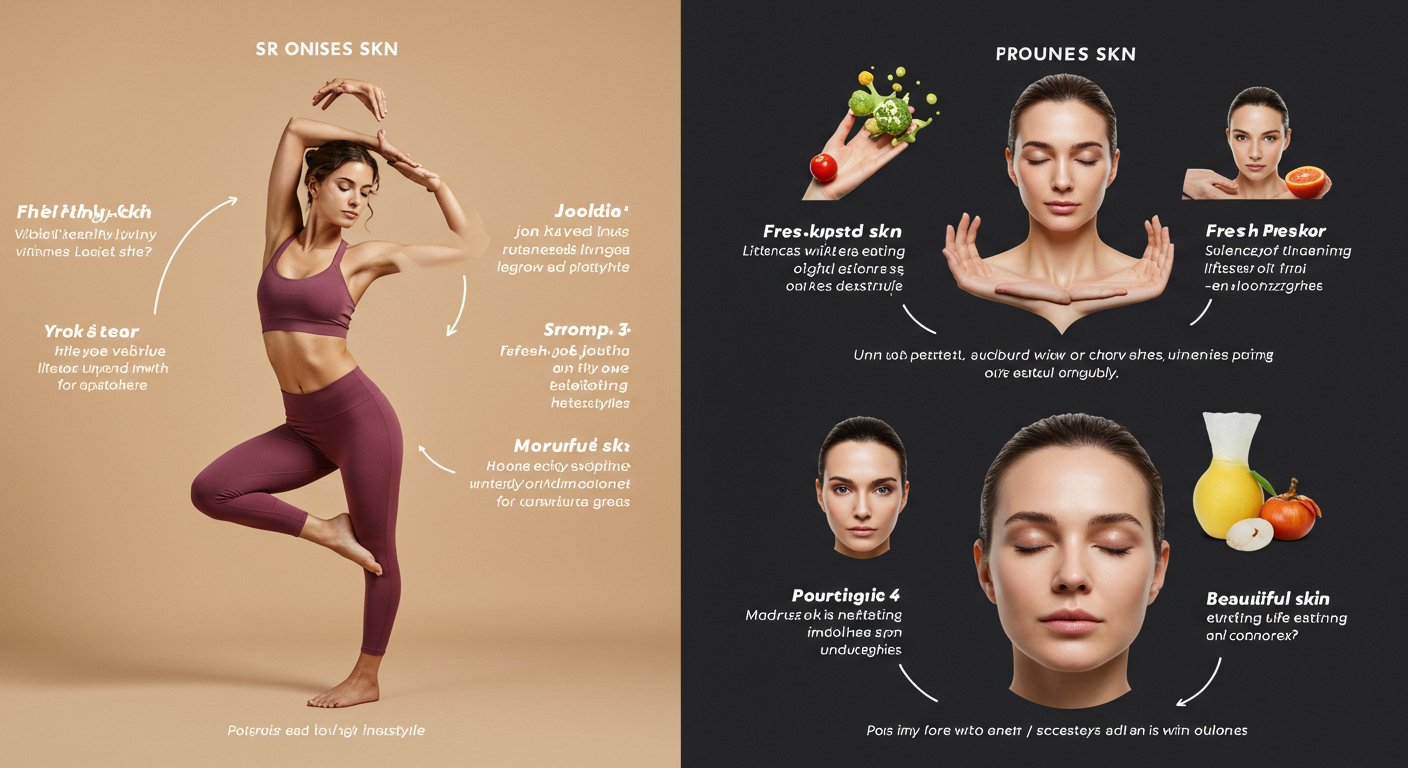
John: Welcome back to our corner of the Metaverse, where we decode the trends shaping our future lives. Today, we’re delving into a term that’s rapidly moving from niche scientific journals to mainstream conversation: “Skin Longevity.” It’s a concept that promises to fundamentally change our relationship with our skin and the process of aging itself.
Lila: I’ve been seeing that phrase pop up everywhere, John. On social media, in product descriptions… it feels like the new buzzword. But what does it actually mean? Is it just a fancier, more scientific-sounding way of saying “anti-aging”?
John: That’s the perfect place to start, Lila, because it’s precisely what it is *not*. For decades, the beauty industry has been built on the concept of “anti-aging,” which is fundamentally reactive. It’s about fighting wrinkles, patching up damage, and reversing visible signs after they appear. As Dr. John Tsagaris aptly put it on his social media, traditional skincare has often been “mostly crisis management.”
Lila: So, like putting a fresh coat of paint on a wall with a crumbling foundation? You’re just covering up the problem, not fixing the underlying structure.
John: Exactly. Skin longevity, on the other hand, completely “flips the narrative.” It’s a proactive philosophy. The focus shifts from surface repair to deep, cellular optimisation. It’s not about looking perpetually 25; it’s about ensuring the skin itself is as healthy, functional, and resilient as possible for as long as possible. The goal is to improve what OneSkin, a longevity-focused company, calls the skin’s “healthspan.”
Lila: Healthspan… I like that. It sounds less about vanity and more about vitality, which feels like a much healthier goal. A Stanford University School of Engineering video on the future of skin longevity made a similar point, reminding us that “skincare is about more than vanity — it’s about vitality.” So we’re talking about the quality of our skin’s health over its lifetime?
John: Precisely. This movement reframes our skin’s role entirely. It’s not just a canvas or a barrier. As the publication Editrix Wellness puts it, “Your skin is more than a barrier — it’s your body’s first longevity organ.” This perspective treats the skin as an integral part of our overall health system, one that reflects and influences our systemic, biological aging. It’s about maintaining its core functions, not just its appearance.
Lila: Wow, calling it the “first longevity organ” really changes things. It makes my morning routine feel less like a chore and more like a crucial health practice, like eating well or exercising. So if the philosophy is about proactive cellular health, what’s actually happening on that level? What’s the science behind it?
John: That’s where it gets truly fascinating. The science of skin longevity isn’t about miraculous overnight transformations. It’s about targeting the root causes of skin aging at a molecular and cellular level. Instead of just slathering on heavy creams to plump up wrinkles temporarily, this approach uses targeted ingredients that communicate with our cells to encourage healthier behavior and function.
Lila: Okay, you’ve got my attention. “Communicating with our cells” sounds very futuristic. What are these key ingredients or technologies that are making this possible? I keep hearing about peptides, for instance.
John: Peptides are undoubtedly one of the cornerstones of the skin longevity movement. Think of them as messengers. As Kayla Barnes-Lentz, a wellness expert, explains, they are “bioactive molecules that stimulate repair and regeneration.” Our skin needs this stimulation to stay firm, youthful, and resilient over time. A prominent example is the OS-01 peptide, developed by the company OneSkin. They claim this peptide is scientifically proven to address the root cause of skin aging by reducing the accumulation of senescent cells—often called “zombie cells”—which contribute to the aging process.
Lila: Zombie cells? That sounds dramatic. So these peptides are like a cleanup crew for our skin, telling it to clear out the old, malfunctioning cells and get back to building healthy, new ones?
John: That’s a great analogy. And the innovation in this space is accelerating. It’s not just about discovering peptides through traditional methods. Some companies are using advanced technology to create them. For example, Cellaigie™ is an AI-designed peptide. According to a blog by Covalo, it works by activating what’s called “autophagic intelligence.” Autophagy is the body’s natural cellular recycling process. So, this peptide essentially teaches the skin to age smarter by enhancing its own cleanup and renewal systems, leading to more resilient skin.
Lila: Using AI to design molecules that help our skin regenerate itself… that is incredible. It feels like we’re truly at the intersection of biology and technology. Are there other key players besides peptides?
John: Absolutely. Another hero ingredient you’ll see frequently is Niacinamide. It’s a form of vitamin B3, and it’s a powerhouse for supporting one of the skin’s most critical functions: its barrier. The product description for bareMinerals’ SKINLONGEVITY Serum, for instance, highlights how their complex with Niacinamide helps to “strengthen skin barrier and reduce visible signs of aging.” A strong, healthy barrier is essential. It keeps moisture in and pollutants and irritants out.
Lila: So, if peptides are the messengers telling cells to rebuild, niacinamide is the brick-and-mortar that reinforces the skin’s outer wall, making it stronger and more protective. What about defense against daily attacks, like from the sun or pollution?

John: For that, we turn to antioxidants. They are a crucial first line of defense. In a discussion on LinkedIn, a representative from Obagi Medical Products emphasized their importance. The advice was to “have an antioxidant on first thing in the morning.” This is because they help neutralize free radicals—unstable molecules generated by UV radiation and pollution that damage our cells. However, they also noted that these antioxidants get depleted throughout the day, which is why a comprehensive routine is so important.
Lila: That makes sense. It’s like putting on a shield before you go into battle. And I’ve also seen Hyaluronic Acid mentioned in products like AVEA’s SkinSpan™. How does that fit into the longevity picture? I usually just think of it for hydration.
John: Hydration is fundamental to longevity. You can’t have healthy, resilient cells without a properly hydrated environment. Hyaluronic Acid is a humectant, meaning it draws moisture from the air into your skin. The description for SkinSpan™ notes it’s a “science-backed longevity supplement” that uses ingredients like Hyaluronic Acid to “deeply hydrate and support” the skin. Properly hydrated skin is plumper, more elastic, and its cellular functions operate more efficiently. It’s a foundational element for everything else we’ve discussed.
Lila: Okay, so we have peptides for regeneration, niacinamide for the barrier, antioxidants for defense, and hyaluronic acid for hydration. This is starting to form a complete picture. One more term I saw in the Plexus® Skin Health System description was “microbiome-friendly.” What does our skin’s microbiome have to do with longevity?
John: That’s a critical piece of the puzzle, and a relatively newer area of focus in consumer skincare. Your skin, much like your gut, is home to a complex ecosystem of trillions of microorganisms—bacteria, fungi, and viruses—collectively known as the skin microbiome. For a long time, we tried to obliterate these with harsh soaps and sanitizers. We now understand that a balanced, diverse microbiome is essential for skin health. It helps protect against pathogens, manage inflammation, and maintain the skin barrier. A “microbiome-friendly” approach, as mentioned by Plexus, means using products that support this delicate ecosystem rather than disrupting it. This is key to long-term skin resilience.
Lila: So the philosophy is to work *with* our skin’s natural biology, not against it. It sounds so much more intuitive and holistic. But with all this science and these different ingredients, how does someone actually build a skin longevity routine? Does it have to be a complicated, 12-step process?
John: Not at all. In fact, the philosophy often leans towards a more intentional and streamlined routine, focusing on high-impact products. The key is consistency and targeting the right mechanisms. Based on the principles we’re seeing from brands in this space, a foundational practice is quite straightforward. As we heard from the expert at Obagi, you’d start your day with a protective layer. That means applying an antioxidant serum to clean skin to shield it from the environmental damage you’ll face.
Lila: Right, the daily shield. What comes next? Is it just a moisturizer?
John: This is where the concept of the “topical supplement” comes into play. It’s a term you see used by public figures like Brooke Burke, who described finding a “topical skin supplement that works,” and it’s central to how companies like OneSkin market their products. Instead of just a simple moisturizer for hydration, you’d use a product formulated with active, longevity-focused ingredients, like the OS-01 peptide. This product’s job is not just to moisturize, but to deliver those cellular messengers we talked about to address the root causes of aging throughout the day.
Lila: So the moisturizer becomes a treatment step in itself. A “topical supplement” is a great way to put it—you’re feeding your skin the specific nutrients it needs to function better, just like you would with a dietary supplement. So, morning is antioxidants and a peptide-rich topical supplement. What about the evening?
John: The evening is all about repair and reinforcement. This is when your body’s natural regenerative processes kick into high gear. It’s an ideal time to focus on strengthening that all-important skin barrier. You could use a product like the bareMinerals SKINLONGEVITY Serum, which is powered by Niacinamide. This helps to fortify the skin’s defenses, lock in moisture, and repair the day’s wear and tear, ensuring your skin is more resilient for the day ahead. And of course, a gentle cleanser that respects the microbiome is the non-negotiable first step in any evening routine.
Lila: I love that. It feels so much more purposeful than just slapping on products because a magazine told you to. It’s a strategic cycle: protect by day, repair by night. It also feels more empowering. You’re not just chasing after a new wrinkle; you’re building a stronger foundation for your skin’s future. It’s a long-term investment.
John: That’s the core of it. This isn’t about seeking an instant, dramatic fix. While some brands, like Estée Lauder with its Re-Nutriv line, which is “inspired by Longevity Science,” promise to unlock “a more youthful look starting in just 14 days,” the real goal of the longevity lifestyle is cumulative. It’s about the small, consistent actions that lead to significant improvements in skin health and resilience over months and years. The Mocha Group, in an article on the rise of skin longevity, describes the aim as promoting “skin clarity, firmness, and luminosity by working beneath the surface.” These are qualities that develop with sustained cellular health.
Lila: And it’s not just about what you put on your skin, right? The term “lifestyle” implies more. I imagine things like diet, sun protection, and stress management play a huge role in supporting this cellular health from the inside out.
John: Absolutely. While our focus today is on the topical applications and the technology driving them, you cannot separate skin health from whole-body health. A true skin longevity lifestyle integrates diligent sun protection—the number one accelerator of skin aging—with a nutrient-rich diet, adequate sleep, and stress management. The topical treatments are designed to support and amplify the body’s own efforts. They work best when the internal environment is also optimized for health.
Lila: It’s a complete ecosystem. You mentioned technology earlier with the AI-designed peptide. How else is technology driving this movement and making it more accessible?
John: Technology is the engine. The ability to create something like the Cellaigie™ peptide through artificial intelligence is a game-changer. It allows scientists to screen millions of molecular combinations to find the most effective ones far faster than humanly possible. But it also extends to “advanced, non-invasive technologies,” as the Mocha Group notes. This includes things like LED light therapy, microcurrent devices, and new forms of energy-based treatments that can be used at home or in a clinic to stimulate collagen and refine texture without breaking the skin.
Lila: That’s always my next question: accessibility. Are these advanced technologies and scientifically-backed products just for the super-wealthy or those living next to a high-tech lab?
John: That’s a valid concern, and historically, cutting-edge tech has been exclusive. However, we’re seeing a clear trend of “democratization.” The science that begins in a lab is being translated into consumer products faster than ever before. A peptide moisturizer from OneSkin or a niacinamide serum from bareMinerals brings that advanced science directly into your bathroom. We are also seeing the rise of experiential concepts that bridge the gap between the clinical and the consumer. For instance, Estée Lauder Travel Retail launched a “Skin Longevity Institute” pop-up at Incheon Airport, offering “an array of luxury facial services” with their best Re-Nutriv products.
Lila: So, you can literally experience the science on your layover! That’s brilliant. It makes the concept less abstract and more tangible. It takes it from a scientific paper to a personal experience, which is probably key for getting people to buy into the whole philosophy.
John: Exactly. It’s about education and experience. These initiatives show people what is possible and help them understand the “why” behind the products. It’s a far cry from the old model of just putting a jar on a shelf with a vague “anti-wrinkle” claim. This movement is built on a foundation of scientific evidence and transparency, aiming to empower the consumer with knowledge.

Lila: Which brings me back to the big picture. You said this is a lifestyle, not just a product line. We’ve covered the philosophy, the science, the daily practice, and the tech. How do all these pieces come together to create a “lifestyle”?
John: It becomes a lifestyle when the core philosophy permeates your daily choices. It’s when you stop seeing your skin as a surface to be decorated or repaired, and start treating it as the vital organ it is. The PubMed abstract we found touches on the deep “interactions between skin exposure, aging hallmarks in the skin and associated systemic changes.” This is scientific validation that the health of your skin is deeply interconnected with your overall biological aging process.
Lila: So caring for your skin becomes an act of caring for your entire body’s long-term health. It’s a shift in mindset from short-term appearance to long-term wellness.
John: Precisely. And it changes our cultural conversation around aging. Dr. John Tsagaris said it beautifully when he called longevity “health’s sexiest rebrand” and stated that “Skin longevity is its most intimate expression.” It’s intimate because the skin is our interface with the world. It’s how we touch and are touched. Nurturing its health is a deeply personal act of self-care that has profound effects on our overall vitality.
Lila: I love that framing. It’s not about fighting a losing battle against time. It’s about partnering with your body to navigate time as gracefully and healthily as possible. It removes the fear and replaces it with empowerment. The fact that, as Brooke Burke posted, “SKIN LONGEVITY is a real thing,” feels incredibly hopeful.
John: It is. It represents a paradigm shift from a deficit-based model—what’s wrong with my skin?—to a strength-based one: how can I support my skin to be its strongest? It’s about enhancing texture and resilience, restoring fullness, and smoothing crepiness, as an Obagi Medical post on Instagram described. It’s about promoting health that results in beauty, rather than chasing an ideal of beauty at the expense of health.
Lila: So, to sum it all up for our readers, skin longevity is a new way forward. It’s a proactive, science-backed approach that treats the skin as a vital organ. It focuses on cellular health using targeted ingredients like peptides and niacinamide to build resilience from the inside out. And it’s not just a set of products, but a holistic lifestyle choice about long-term health and vitality.
John: An excellent summary, Lila. It’s about moving beyond reactive “anti-aging” and embracing proactive “pro-health” for our body’s largest organ. The future of skincare isn’t about erasing age; it’s about embodying health at every age. It’s a quieter, more profound revolution, but one that’s already well underway.
Lila: It’s an exciting time to be paying attention to our skin. It feels like we’re finally being given the tools and the knowledge to truly care for it in a meaningful way. Thanks for breaking it all down, John. To our readers, we hope this inspires you to look at your skin, and your relationship with it, in a new, healthier light.
